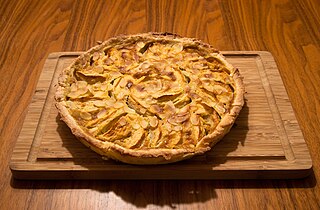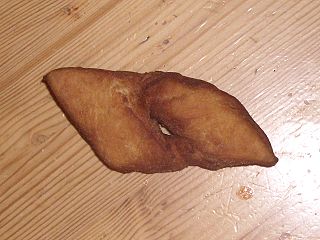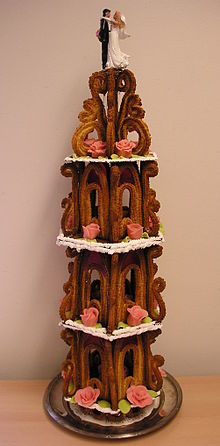
A Danish pastry is a multilayered, laminated sweet pastry in the viennoiserie tradition. It is thought that some bakery techniques were brought to Denmark by Austrian bakers, and originated the name of this pastry. The danish recipe is however different from the Viennese one and has since developed into a Danish specialty.

Zeppola, sometimes called frittelle, and in Sardinia italianized zippole or zeppole sarde from the original Sardinian tzípulas, is an Italian pastry consisting of a deep-fried dough ball of varying size but typically about 4 inches (10 cm) in diameter. This fritter is usually topped with powdered sugar, and may be filled with custard, jelly, cannoli-style pastry cream, or a butter-and-honey mixture. The consistency ranges from light and puffy, to bread- or pasta-like. It is eaten to celebrate Saint Joseph's Day, which is a Catholic feast day.

A wedding cake is the traditional cake served at wedding receptions following dinner. In some parts of England, the wedding cake is served at a wedding breakfast; the 'wedding breakfast' does not mean the meal will be held in the morning, but at a time following the ceremony on the same day. In modern Western culture, the cake is usually on display and served to guests at the reception. Traditionally, wedding cakes were made to bring good luck to all guests and the couple. Nowadays, however, they are more of a centerpiece to the wedding and are not always even served to the guests. Some cakes are built with only a single edible tier for the bride and groom to share, but this is rare since the cost difference between fake and real tiers is minimal.

Marzipan is a confection consisting primarily of sugar and almond meal, sometimes augmented with almond oil or extract.

Shortbread or shortie is a traditional Scottish biscuit usually made from one part white sugar, two parts butter, and three to four parts plain wheat flour. Shortbread does not contain any leavening, such as baking powder or baking soda. Shortbread is widely associated with Christmas and Hogmanay festivities in Scotland, and some Scottish brands are exported around the world.

A mille-feuille, also known by the names Napoleon in North America, vanilla slice in the United Kingdom, and custard slice, is a French dessert made of puff pastry layered with pastry cream. Its modern form was influenced by improvements made by Marie-Antoine Carême.

Ostkaka, ost meaning "cheese" and kaka meaning "cake" in Swedish, is known as Swedish cheesecake or Swedish curd cake, it is a Swedish dessert that has its roots in two different parts of Sweden, Hälsingland and Småland, though there are some differences between ostkaka from Hälsingland resembling halloumi in texture, and the soft-grained ostkaka from Småland. Originally, the food comes from småland, ostkaka is made with raw milk and cheese rennet. However, these days most people simply use cottage cheese instead, which is much faster, and gives the same flavor and texture.

Kransekage (Danish) or kransekake (Norwegian) is a traditional Danish and Norwegian confection, often eaten on special occasions in Scandinavia. In English, the name means 'wreath cake'. In Norway it is alternatively referred to as tårnkake and often prepared for Constitution Day celebrations, Christmas, weddings, and baptisms. In Denmark it is typically eaten as part of New Year celebrations, while a variation of the cake, overflødighedshorn, is traditionally served at weddings and baptisms.

Cake decorating is the art of decorating a cake for special occasions such as birthdays, weddings, baby showers, national or religious holidays, or as a promotional item.

Cardamom breads, including the Finnish pulla and Swedish kardemummabröd and kardemummabullar, are a group of enriched breads or pastry flavored with cardamom. They are eaten throughout the year, typically with coffee or tea.

Kürtőskalács is a spit cake specific to Hungarians from Transylvania, more specifically the Székelys. Originally popular in the Székely Land, it became popular in both Hungary and Romania. The first written record dates back to 1679 and was found in the village of Úzdiszentpéter, while the first recipe appears in a manuscript cookbook dated in 1781. Earlier a festive treat, now it is part of everyday consumption. A similar pastry to kürtőskalács is Baumstriezel, originating in the Transylvanian Saxon communities.

Normandy tart is a shortcrust pastry-based variant of the apple tart made in Normandy filled with apples, sliced almonds and sugar, topped with creamy egg custard and baked until the topping is slightly caramelised. It is also known in French as la Tarte Normande.

A Jésuite is a triangular, flaky pastry filled with frangipane cream and topped with sliced almonds and powdered sugar. The pastry originated in France and the name refers to the triangular shape of a Jesuit's hat.

Klenät, kleinur, klena, klejne, kleina, kleyna, and fattigmann are all names for angel wings, a fried pastry common in the Nordic countries as well as the rest of Europe and the United States. In nearby countries and Eastern European countries. The name is related to klen, the Swedish term for "weak", but is originally of Low German origin, which may indicate that the pastry was originally German. It is made from flattened dough cut into small trapezoids. A slit is cut in the middle and then one or both ends pulled through the slit to form a "knot". The kleina is then deep-fried in oil or another kind of fat. Subsequently can be sprinkled with powdered sugar and cinnamon.

Mazurek is a variety of cake baked in Poland for Easter. It has a flat shape and is very sweet.

Shekarbura is a sweet pastry.
















